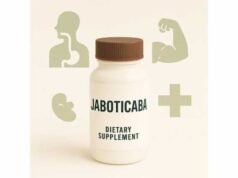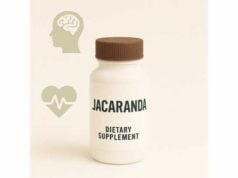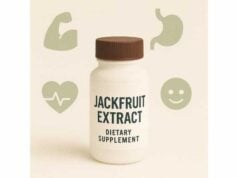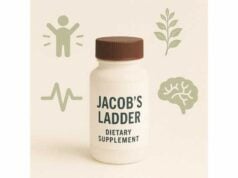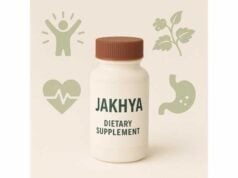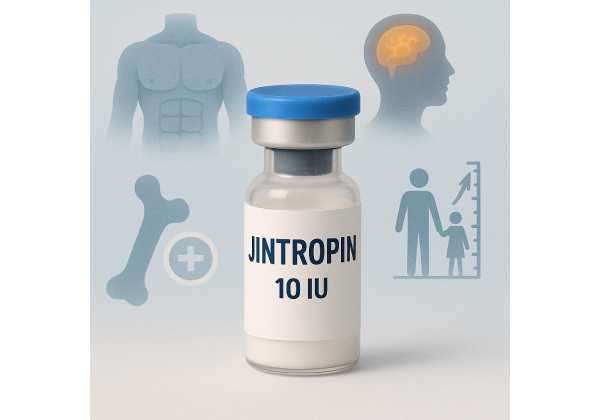
Jintropin is a brand of recombinant human growth hormone (rhGH, generic name: somatropin) manufactured in China and used to treat medically confirmed growth hormone deficiency (GHD) and select growth disorders. Like other somatropin products, it is biologically identical to pituitary GH and acts mainly by raising insulin-like growth factor-1 (IGF-1), which drives linear growth in children and supports body composition, bone metabolism, and cardiometabolic health in adults with true deficiency. It is not a fat-loss drug, an anti-aging tonic, or a safe shortcut for athletic performance. Outside of clinician-prescribed, guideline-based therapy, the risks quickly outweigh benefits—particularly for glucose control, edema, and the heart. This guide explains how Jintropin works, where it fits legitimately, dosing principles doctors use, practical safety steps, and who should avoid it. You will also learn how medical teams tailor treatment to age, sex, body size, estrogen status, and IGF-1 targets—plus the red flags that warrant urgent evaluation.
Essential Insights
- Somatropin increases IGF-1 to correct clinically proven GH deficiency and improve growth, body composition, and quality of life.
- Typical adult starting dose is 0.1–0.3 mg per day, titrated to bring IGF-1 into the age-adjusted normal range.
- Side effects include edema, joint pain, carpal tunnel, headache, and worsened glucose tolerance; rare but serious risks exist.
- Avoid non-prescribed use, performance enhancement, and anti-aging purposes; athletes require a Therapeutic Use Exemption.
Table of Contents
- What is Jintropin and how it works
- Clinically proven benefits and limits
- How to use Jintropin correctly
- Dosing by age and condition
- Side effects, interactions, and who should avoid
- What the evidence and guidelines say today
What is Jintropin and how it works
Jintropin basics. Jintropin is a daily injectable somatropin formulation made by GeneScience Pharmaceuticals. Somatropin is a 191-amino-acid peptide that is structurally identical to endogenous human growth hormone. In clinical practice, somatropin is used to replace or supplement GH in people who have documented deficiency (children or adults) or selected growth disorders when the benefit–risk balance is favorable under a specialist’s care.
Mechanism of action. Somatropin binds to GH receptors in the liver and peripheral tissues, stimulating synthesis of IGF-1, which mediates most anabolic and growth effects. In children, adequate IGF-1 supports growth plate activity and linear height gain. In adults with GHD, restoring physiologic GH/IGF-1 improves body composition (less visceral fat, more lean mass), bone turnover toward normal, and exercise capacity and quality of life metrics. Somatropin also influences lipid and carbohydrate metabolism, which is why monitoring glucose and lipids is part of care.
What Jintropin is—and isn’t. Jintropin is one brand among many somatropin products worldwide. It is not approved in every country; availability and labeling vary by jurisdiction. In all regions, somatropin is a prescription-only therapy for narrow, evidence-based indications. Using any GH product for anti-aging, muscle building, or body recomposition without medical indication is unsafe and often illegal. Moreover, counterfeit growth hormone products exist in informal markets; these may contain wrong doses or contaminants.
Pharmacokinetics in brief. After subcutaneous injection, somatropin is absorbed over several hours; its effective half-life is prolonged by slow absorption even though the plasma half-life is short. Circulating IGF-1 rises gradually and is usually measured at least 5–7 days after a dose change to judge steady-state effect. Somatropin is metabolized by proteolysis; classic cytochrome P450 drug–drug interactions are not expected, but GH may alter cortisol and thyroid hormone dynamics, unmasking adrenal or thyroid insufficiency in some patients.
Regulatory and sports context. Human growth hormone is prohibited in sport at all times; detection methods include isoform and biomarker assays. Athletes on legitimate GH replacement must seek a Therapeutic Use Exemption (TUE) and comply with documentation and testing requirements.
Bottom line. Jintropin works by normalizing the GH–IGF-1 axis in truly deficient patients. The same pathways that help in deficiency can be harmful if pushed beyond physiologic ranges. Appropriate use starts with a solid diagnosis and continues with careful titration and monitoring.
Clinically proven benefits and limits
Children with GH deficiency (GHD). In pediatric GHD, daily somatropin reliably increases growth velocity, helps normalize height standard deviation scores (SDS), and supports bone accrual. The earlier the diagnosis and the more consistent the adherence, the closer children can track toward their genetic height potential. In transition-age youth (late teens), an evaluation determines whether deficiency persists; when it does, continuing GH can protect bone mass and body composition.
Adults with confirmed GHD. Adults often present with increased visceral adiposity, reduced lean mass, decreased bone density, unfavorable lipids, low energy, and impaired quality of life scores. Somatropin replacement can reduce waist circumference, increase lean mass, improve some lipid parameters, and modestly improve exercise performance and self-reported vitality. Benefits accumulate over months; dose adjustments aim to keep IGF-1 within the age-adjusted normal range rather than chasing supraphysiologic levels.
Special pediatric indications (brand-agnostic). Beyond classic GHD, guidelines support somatropin in conditions such as Turner syndrome, Prader–Willi syndrome (with strict screening for sleep-disordered breathing), small for gestational age (SGA) without catch-up growth, chronic kidney disease–related growth failure, and idiopathic short stature (ISS) in carefully selected cases. The expected benefit differs by diagnosis: for example, Turner syndrome goals include height gain and possible cardiometabolic benefits, while Prader–Willi management emphasizes body composition, function, and behavior alongside height.
Long-acting GH vs daily somatropin. Multiple long-acting GH (LAGH) options now exist in some markets. Jintropin itself is a daily somatropin; a separate GeneScience product (Jintrolong) is PEGylated for weekly dosing in certain regions. While weekly dosing may improve convenience, clinicians still target the same physiologic IGF-1 window and monitor for similar adverse effects. Product interchangeability is not assumed; titration and lab timing can differ.
Limits and misconceptions. Somatropin is not a treatment for common short-term fatigue, general well-being without deficiency, or obesity. In non-deficient individuals, GH can impair glucose tolerance, raise blood pressure, and cause edema and carpal tunnel symptoms without delivering meaningful, durable performance or aesthetic gains. For children who are simply “late bloomers,” reassurance and monitoring beat unnecessary injections.
What success looks like. In kids: sustained height SDS improvement and growth velocity aligned with mid-parental height, with normal IGF-1 and manageable side effects. In adults: better body composition and energy, stable or improved bone indices, lipids trending favorably, and IGF-1 in range—achieved with the lowest effective dose.
How to use Jintropin correctly
1) Confirm the diagnosis—do not skip this step.
Proper use starts with a specialist evaluation (pediatric or adult endocrinology). In children, auxology (growth patterns), bone age, and validated GH stimulation tests help confirm GHD or alternative indications. In adults, testing is individualized; many require formal stimulation testing unless they have clear structural pituitary disease with multiple hormone deficits and very low IGF-1. Self-diagnosis based on symptoms or a single IGF-1 value is unreliable.
2) Individualize the dose and titrate slowly.
Clinicians typically begin with low daily doses and increase gradually every 4–8 weeks, guided by IGF-1, clinical response, and side effects. Age, sex, body mass index, estrogen route (oral estrogen can blunt GH action), and comorbidities all influence dosing. The aim is physiologic replacement, not pharmacologic excess.
3) Learn proper injection technique.
Daily subcutaneous injections rotate among the abdomen, thighs, upper arms, or buttocks to minimize lipoatrophy. Pens or cartridges should be stored as directed, never frozen, and inspected for clarity. A new needle is used each time; sharps disposal follows local rules. Families often benefit from a teaching session and a written checklist to support adherence.
4) Monitor what matters.
During dose titration, clinicians typically:
- Check IGF-1 after steady state (about a week on a new dose) and every 3–6 months thereafter.
- Review glucose (fasting glucose or HbA1c) and lipids periodically, especially in adults or those with risk factors.
- Track blood pressure, edema, arthralgia, and paresthesias at each visit.
- In children: measure height/weight every 3–6 months, monitor for headaches/visual changes (pseudotumor cerebri symptoms), and consider thyroid function.
- In Prader–Willi syndrome: screen and manage sleep-disordered breathing before and during treatment.
5) Know when to pause or adjust.
Stop GH and call the care team for severe edema, shortness of breath, marked headaches with visual changes, significant hyperglycemia, or any signs of malignancy. GH is contraindicated in active malignancy and critical illness; it is paused in acute complications such as severe respiratory failure or after major trauma until the patient stabilizes.
6) Understand the legal and sports implications.
Somatropin is prescription-only, with restricted uses. Distribution or use outside approved medical indications may violate national laws. In competitive sport, GH is prohibited; if you have bona fide GHD, discuss a Therapeutic Use Exemption well before competition.
7) Keep expectations grounded.
Even on the right dose, changes in body composition and energy are gradual. Many adults notice reduced central fat and improved stamina over several months rather than weeks. Children’s height velocity picks up over the first 6–12 months and then steadies.
Dosing by age and condition
Important: the ranges below are educational illustrations of common practice patterns for somatropin products. Your exact plan depends on the product label in your country, your diagnosis, age, weight, hormones, and lab results. Always follow your clinician’s instructions.
Adults with confirmed GHD
- Starting dose: typically 0.1–0.3 mg/day. Older adults or those with obesity or diabetes risk often begin at 0.1–0.2 mg/day. Younger adults and those transitioning from pediatric care may start a bit higher.
- Titration: increase by 0.1–0.2 mg/day every 4–8 weeks to bring IGF-1 into the age-adjusted normal range (often targeted around 0 to +1 SDS), while minimizing side effects.
- Typical maintenance: 0.2–1.0 mg/day, individualized. Women on oral estrogen may need higher doses than men or women on transdermal estrogen.
- Monitoring cadence: IGF-1 after 1–2 weeks on a new dose, then every 3–6 months; periodic checks of glucose, lipids, and blood pressure; symptom review each visit.
Children and adolescents
Doses are weight- or body-surface-area–based, divided as daily injections:
- GHD: about 0.16–0.24 mg/kg/week (some centers use up to 0.30 mg/kg/week), split into daily doses.
- Turner syndrome: about 0.33–0.45 mg/kg/week.
- Prader–Willi syndrome: around 0.24 mg/kg/week, with mandatory evaluation for sleep apnea before starting.
- SGA without catch-up growth: roughly 0.23–0.47 mg/kg/week.
- Chronic kidney disease–related short stature: commonly 0.35 mg/kg/week.
- Idiopathic short stature (ISS): up to 0.37 mg/kg/week in carefully selected cases after shared decision-making.
Transition-age youth
If biochemical testing confirms persistent GHD, clinicians often re-start or continue GH at adult-style low doses (for example, 0.2–0.4 mg/day) and titrate to IGF-1 within target range. The goals shift from height to bone mass, body composition, metabolic health, and well-being.
Long-acting GH considerations
Weekly products require different monitoring schedules and trough/peak timing for IGF-1. Jintropin itself is a daily GH; if you switch to or from a weekly product, your team will retitrate and re-educate you on timing and labs.
Why dose precision matters
Somatropin has a narrow therapeutic window in adults: too little yields no benefit; too much increases edema, paresthesias, and glucose issues. For children, oversized doses may push IGF-1 too high or accelerate bone age disproportionately. The best outcomes come from steady, conservative titration and regular feedback between patient and team.
Side effects, interactions, and who should avoid
Common, dose-related effects
- Fluid retention: ankle swelling, weight gain from water, puffiness in hands/face.
- Musculoskeletal: joint or muscle pain, carpal tunnel–like numbness/tingling, morning stiffness.
- Metabolic: mild hyperglycemia or reduced insulin sensitivity, particularly in adults, those with central adiposity, or with family history of diabetes.
- Headache or mild hypertension: usually early in therapy or after a dose increase.
- Injection-site reactions: redness, itching, or lipoatrophy if sites are not rotated.
Less common but important
- Benign intracranial hypertension (pseudotumor cerebri): severe headache, visual changes, or vomiting—especially in the first months in children; requires evaluation and temporary discontinuation.
- Slipped capital femoral epiphysis (SCFE): hip or knee pain and limp in rapidly growing children; urgent orthopedic assessment is needed.
- Scoliosis progression: monitor during growth spurts; GH does not cause scoliosis but rapid growth can unmask it.
- Sleep-disordered breathing: particularly relevant in Prader–Willi syndrome; screen and manage before and during therapy.
- Neoplasia considerations: GH is contraindicated with active malignancy; in survivors of childhood cancer, use requires specialist protocols and careful risk–benefit review.
Absolute or relative contraindications
- Active malignancy or proliferative/severe non-proliferative diabetic retinopathy.
- Acute critical illness following major surgery, trauma, or respiratory failure.
- Hypersensitivity to somatropin or product excipients.
- Uncontrolled intracranial hypertension.
Medication and physiology interactions
- Glucocorticoids: suppress the GH–IGF-1 axis; excessive doses blunt GH efficacy.
- Thyroid and adrenal axes: GH can unmask hypothyroidism or central hypoadrenalism by increasing clearance of T4 or altering cortisol metabolism—your clinician may adjust levothyroxine or hydrocortisone.
- Diabetes medications: dose adjustments may be required if glucose levels rise.
- Oral estrogen: reduces GH’s hepatic IGF-1 generation; transdermal routes mitigate this effect.
Who should avoid non-prescribed GH entirely
- Athletes seeking performance enhancement (prohibited and detectable).
- Individuals pursuing anti-aging or body recomposition without a clear medical indication.
- Anyone with a history of GH-related severe adverse effects or with the contraindications listed above.
Safety habits that reduce risk
Use the lowest effective dose, titrate slowly, keep IGF-1 in range, rotate injection sites, and keep every follow-up. Report new headaches, visual changes, hand numbness, shortness of breath, rapid weight gain, or worsening glucose immediately.
What the evidence and guidelines say today
Guideline consensus
Modern endocrine guidelines agree on several pillars: diagnose GHD with validated protocols; start low-dose daily somatropin and titrate to IGF-1 in the age-adjusted normal range; monitor side effects and metabolic markers; and tailor therapy to age, sex, and estrogen status. In pediatrics, indications extend beyond GHD to selected conditions (Turner syndrome, Prader–Willi syndrome, SGA without catch-up, CKD-related growth failure, ISS under strict criteria). In adults, therapy focuses on body composition, bone health, lipids, exercise capacity, and quality of life.
Evidence on Jintropin and related products
Randomized studies in China have evaluated Jintropin (daily somatropin) in idiopathic short stature and other pediatric groups, showing improved growth velocity and acceptable short-term safety when used under specialist care. Long-acting Jintrolong (PEGylated rhGH) has been investigated for weekly dosing; while convenient, it requires distinct monitoring strategies. Across products, the therapeutic objective remains the same: physiologic replacement, not supraphysiologic enhancement.
Regulatory and legal landscape
Somatropin products differ by country in brand names, devices, approved indications, and labeling. Some brands are not approved in certain regions; importing or distributing unapproved GH can violate national laws. In the United States and many other jurisdictions, distributing GH for non-medical uses (e.g., anti-aging or performance) is illegal, and regulators actively target unapproved online sales. Patients should obtain GH only through legitimate healthcare channels.
Anti-doping rules
Growth hormone is on the Prohibited List year-round. Athletes with genuine GHD who require therapy must seek a Therapeutic Use Exemption and be prepared for testing with GH isoform or biomarker assays. Failure to obtain a TUE can result in sanctions even if the medication is legitimate.
Risks vs benefits
When used exactly as indicated, benefits in children (height, bone accrual) and in adults (body composition, bone and metabolic markers, quality of life) typically outweigh risks. The margin narrows at higher doses or in people with metabolic vulnerabilities. Long-term safety data continue to accumulate; current guidance supports careful, individualized therapy with ongoing monitoring rather than broad, off-label use.
Practical takeaway
If you or your child may have GH deficiency, partner with an endocrinology team. Expect a stepwise process: confirm diagnosis, discuss realistic goals, start low, monitor, and adjust. Avoid non-prescribed GH, counterfeit products, and athletic misuse. For those who qualify, thoughtful somatropin therapy can be life-changing—safely.
References
- AMERICAN ASSOCIATION OF CLINICAL ENDOCRINOLOGISTS AND AMERICAN COLLEGE OF ENDOCRINOLOGY GUIDELINES FOR MANAGEMENT OF GROWTH HORMONE DEFICIENCY IN ADULTS AND PATIENTS TRANSITIONING FROM PEDIATRIC TO ADULT CARE 2019 (Guideline)
- Guidelines for Growth Hormone and Insulin-Like Growth Factor-I Treatment in Children and Adolescents: Growth Hormone Deficiency, Idiopathic Short Stature, and Primary Insulin-Like Growth Factor-I Deficiency 2016 (Guideline)
- NORDITROPIN (somatropin) injection, for subcutaneous use: Prescribing Information 2025 (Label)
- A Randomized Controlled Phase 3 Study on the Efficacy and Safety of Somatropin (Jintropin®) in Prepubertal Children with Idiopathic Short Stature 2022 (RCT)
- Growth Hormone Deficiency – Child, Adolescent and Adult: TUE Checklist 2024 (WADA Guidance)
Disclaimer
This article is for general information and education. It does not replace personalized medical advice, diagnosis, or treatment. Do not start, stop, or change growth hormone therapy without your clinician’s guidance. Somatropin is contraindicated in active malignancy and acute critical illness and must be used cautiously in people at risk for glucose intolerance, intracranial hypertension, or sleep-disordered breathing. Athletes require a Therapeutic Use Exemption to use GH legally in sport. If you experience severe headache, visual changes, shortness of breath, rapid swelling, numbness or tingling in the hands, or high blood sugars while on therapy, seek medical care promptly.
If you found this guide helpful, please consider sharing it on Facebook, X (formerly Twitter), or your preferred platform, and follow us for more evidence-informed health content. Your support helps us continue producing high-quality resources.

